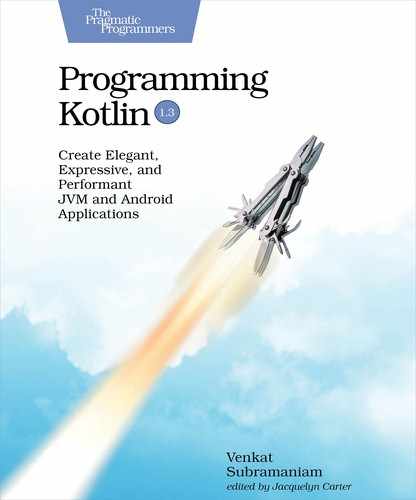Destructuring
Structuring, or construction, is creating an object from values in different variables. Destructuring is the opposite—to extract values into variables from within an existing object. This facility is useful to remove noisy, repetitive code. Kotlin has the destructuring capability much like in languages such as JavaScript. But unlike JavaScript, the destructuring in Kotlin is based on the position of properties instead of the names of the properties.
Let’s start with a piece of code that is verbose and then refactor that code, using destructuring, to make it concise. Triple is a class in the Kotlin standard library that represents a tuple. We’ll look at it further in Using Pair and Triple. For now, we’ll use Triple to return a group of three values:
| | fun getFullName() = Triple("John", "Quincy", "Adams") |
Here’s a traditional, boring, call to the above function, to receive the result and assign to three different variables.
| | val result = getFullName() |
| | val first = result.first |
| | val middle = result.second |
| | val last = result.third |
| | |
| | println("$first $middle $last") //John Quincy Adams |
That took multiple lines of code and a few dot operations. But when the return type of a function is a Pair, Triple, or any data class, we can use destructuring to extract the values into variables, elegantly and concisely. Let’s rewrite the code, this time to use destructuring.
| | val (first, middle, last) = getFullName() |
| | |
| | println("$first $middle $last") //John Quincy Adams |
Four lines reduced to a concise single line of code. It appears like the getFullName() function suddenly returned multiple values—a nice illusion. The three immutable variables first, middle, and last are defined in that line and are immediately assigned the three properties of the result Triple, in the order first, second, and third, respectively. In reality, this works because the Triple class has specialized methods to assist with destructuring; you’ll learn about this later in the book. The order in which the properties are destructured is the same as the order in which the properties are initialized in the source object’s constructor.
Suppose we don’t care about one of the properties of the object being returned. For example, if we don’t want the middle name, we can use an underscore (_) to skip it.
| | val (first, _, last) = getFullName() |
| | |
| | println("$first $last") //John Adams |
Similarly, you may skip more than one property by using multiple _s, like so:
| | val (_, _, last) = getFullName() |
| | |
| | println(last) //Adams |
You may place _ at any position that you want to ignore. If you want to stop at a particular position and ignore the rest, you don’t need to fill all remaining spaces with _s. For example, to get only the middle name we can write:
| | val (_, middle) = getFullName() |
| | |
| | println(middle) //Quincy |
In addition to using destructuring when the return type is a data class, you can also use destructuring to extract key and value from Map entries—see Using Map.
If you’re curious how destructuring works under the hood and what those special methods that I alluded to are, stay tuned; we’ll revisit destructing and explore further in Data Classes.
